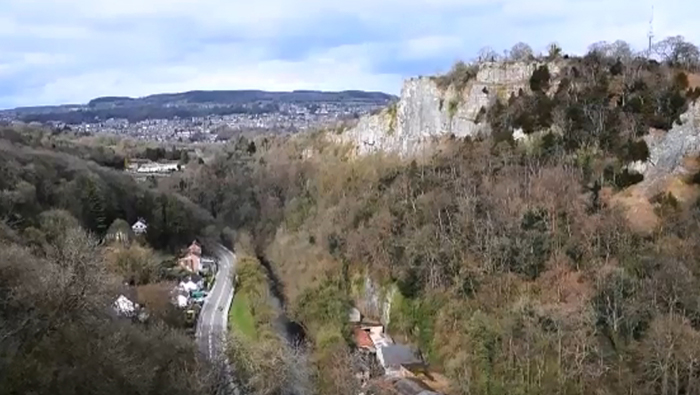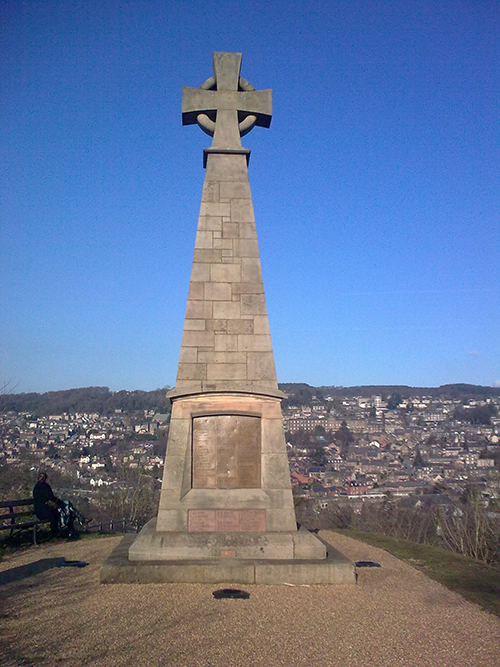High Tor

The imposing High Tor, which dominates Matlock Dale below, is the last place in England where eagles nested.
This popular attraction was upgraded by Derbyshire Dales District Council as part of the Matlock Parks Project. An ambitious £3.6m five-year Heritage Lottery Fund supported programme to restore five historic parks. The project completed in 2008.
Geological activity left a variety of minerals and ores mined in the Matlock Valley for centuries. Lead being the most dominant mined in the area since Roman times.
High Tor contains many lead mines with the most obvious being near the summit now known as Fern and Roman Caves. Workings are recorded here from the 16th to the 18th centuries. An earlier origin is possible, although there is no evidence for Roman working, despite the popular name.
A growing number of visitors came to Matlock Bath during the 18th and early 19th centuries to sample the thermal waters. Then in 1849 the railway arrived, bringing day trippers.
The visitor increase prompted the High Tor Grounds to open to the public by Peter Arkwright.
There were new walks and a carriage ride to the summit, along with the cliff ledge path 'Giddy Edge'. The two lead mines - Fern and Roman 'Caves' - opened as official visitor attractions.
In 1879 the Matlock and High Tor Recreation Company leased the grounds from the Arkwright family. The grounds reopened in 1880 complete with a new entrance from Matlock Bath and a refreshment building on the summit.
In 1924 Matlock Urban District Council bought the grounds and in 1975 the District Council took over the management and maintenance.
Unfortunately the former 'Caves' are no longer open to the public, due to health and safety concerns.
The Matlock Parks Project included woodland management, a new entrance at the Matlock Bath end near to the Cable Car Base Station. It also included improvements to fencing, paths and viewing areas.
Pic Tor Promenade has a peaceful character running between the cliffs and the River Derwent. Here is where you can see former lead mine shafts spotted in the rock face. Riverside paths link the formal Knowleston Gardens to the Pig Tree Meadows. Shady paths through the woodland lead to the War Memorial on the summit which offers a panoramic view of Matlock and its surroundings.
Pic Tor Promenade is an Edwardian development of an area known for lead mining and converted into a public park. The Pic Tor Pleasure Grounds includes the Tor itself where the First World War Memorial is on the summit. Also the more formal Knowleston Gardens and the romantic riverside promenade leading to Pig Tree Meadows.
Two hundred years ago Knowleston Gardens was a hive of industrial activity with hemp yards, lead mining and lime burning. In 1861 this area was landscaped into formal terraces by John Knowles who built the elegant row of houses opposite in 1857.
Pic Tor

Pic Tor Promenade has a peaceful character running between the cliffs and the River Derwent. Here is where you can see former lead mine shafts spotted in the rock face. Riverside paths link the formal Knowleston Gardens to the Pig Tree Meadows. Shady paths through the woodland lead to the War Memorial on the summit which offers a panoramic view of Matlock and its surroundings.
The Origin of the Pic Tor Pleasure Grounds
Pic Tor Promenade is an Edwardian development of an area known for lead mining and converted into a public park. The Pic Tor Pleasure Grounds includes the Tor itself where the First World War Memorial is on the summit. Also the more formal Knowleston Gardens and the romantic riverside promenade leading to Pig Tree Meadows.
Two hundred years ago Knowleston Gardens was a hive of industrial activity with hemp yards, lead mining and lime burning. In 1861 this area was landscaped into formal terraces by John Knowles who built the elegant row of houses opposite in 1857.
Now neither 'Pig Tor' nor the Pig Tree Meadows were accessible from Knowleston Gardens. In the 1890s John Knowles' nephew Henry had a plan to link Matlock Town centre to Matlock Dale along the river.
Before his death in 1898 he released the land on which the Broadwalk in Hall Leys Park was formed. In 1902 Matlock Urban District Council bought Knowleston Gardens, and leased both Pig Tree Meadows and Pic Tor from FC Arkwright.
In 1902 Matlock Urban District Council bought Knowleston Gardens, and leased both Pig Tree Meadows and Pic Tor from FC Arkwright. The plan was to construct a Promenade as a tourist attraction with band kiosks, shelters and water fetes along the half mile promenade.
In 1906 the promenade finally opened but without these attractions, and under the formal name of 'Pic Tor Promenade'. It was the only free promenade in the district as Matlock Bath had recently started to charge entrance fees to its riverside walks.
There is a 'Monet' style footbridge that now provides a more direct link between Pic Tor, Knowleston Place and the popular Hall Leys Park.

